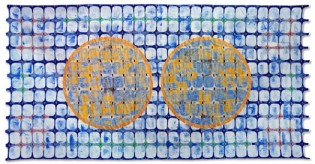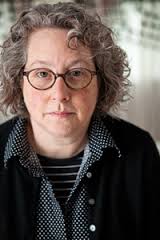Gravitating Towards Grids

Jeanne Williamson doesn’t see fences as a way to keep people in or out, but as a form of protection and an inspiration for art.
About the artist:
Jeanne Williamson is a visual artist, who combines printmaking, painting, collage, and stitching in her artwork. Her pieces may be seen in galleries and museums all over the world, in many books and magazines, and on television. Williamson has a BFA from Philadelphia College of Art (now the University of the Arts), where she majored in fibers/crafts, as well as an MSAEd in art education from the Massachusetts College of Art. In addition to her own body of work, Williamson is also a web designer and the author of the how-to book Uncommon Cards (Running Press, 2013) and also The Uncommon Quilter (Potter Craft/Random House, 2007).
To learn more about the artist, visit her website at www.jeannewilliamson.com.
What is it about grids, which show up in so much of your work, that so intrigue you? Do you see the world in grids when you’re not creating art?
I have always gravitated toward grids throughout my life. Whether while doing math that incorporated grids as a child, or, as an adult, noticing grids both in architecture and in nature, or creating art, grids have played a big part in my life. The grids don’t have to be perfect. As an example, the grids of most construction fences are not perfect, and grids in nature aren’t either, but I still love them.
In 2002, you say you started noticing different patterns, shapes, and sizes of orange construction fences as they were being used at construction sites as a barrier to keep people out of danger, by blocking off the site. Obviously, fences have a grid component, but what else caught your imagination?
I was, and still am, attracted to the different sizes and shapes of the grids in construction fences. I am also fascinated at how they look in different environments, how they crack in the winter, and sag and stretch in the summer. I also like to see, and imagine, how different shapes, colors, and patterns look when looking through the grids of the fences.
You use such an array of techniques, including printmaking, painting, collage, and stitching. Do you tend to learn one technique at a time or experiment with all at the same time? What technique, if any, would you like to add next?
I studied textiles in art school, and continue to work with them. Except for in college, where we learned different textile techniques, most of what I do now as an artist is by experimenting with materials and making up my own techniques as I work. The only exception to that is a few years ago, I did take a workshop about making acrylic “skins” from photographs, which are basically translucent acrylic photographs. When I took the workshop, I didn’t know why I’d want to make them, but have been using them in my work quite frequently since then. That’s the only time I can recall when I purposely made a point to learn a new technique.
Your work varies from as small as 6 inches to all the way up to 35 feet. What are the particular challenges of working with the smallest and largest sizes?
Working in various sizes – from very small to very large – offers a number of challenges. No matter which I’m working with, I need to consider scale as I work. A very small piece may have only a detail from a pattern, or a lot of small pattern. Large pieces incorporate a lot of medium to large pattern. The biggest challenge for me is working very large. What I create in my studio, that might look absolutely huge in that space, can easily become dwarfed when outside. The 35-foot piece was so large, that in my small studio, it almost looked like it was too big and overwhelming. When I installed it on a fence in an empty lot in Kendall Square in Cambridge, Massachusetts, it seemed tiny. It was a good learning experience, since I had never worked that large before.
Tell us about the Tallis and Fence series you created based on photos of your grandfather’s tallis. What inspired you, and how did you go about this?
The Tallis and Fence series is created with acrylic “skins” of photos of my grandfather’s tallis that are then collaged on monoprinted textures of construction fences on fabric that is stitched, painted, and mounted on cradled board. I was inspired to create this series for three reasons. The first was to honor my grandfather who died when I was four years old. The second was because of my limited knowledge of chuppahs before I started my residency at Brandeis. When I thought of chuppahs, all I envisioned was the tallis being supported by poles at traditional weddings. I didn’t actually know if that’s what is used traditionally or not, but that was what I was thinking about. The third reason is I have very few heirloom objects from my family, and it was good to photograph it and use it in my artwork, to have a record of it since it’s probably over 100 years old and very fragile.
While at the HBI, you created a series of Jewish wedding canopies, or chuppot, to display with your theme of fences. It’s an interesting idea to mix fences with a wedding. Do you see the fences as a way to keep people in or out in this series? Explain.
I don’t see fences as a way to keep people in or out. I see them as a form of protection. Similarly, in my research about the chuppah, I found that it suggests the protection of the future the couple will build together in their new home.
There are no comments yet, add one below.





Leave a Comment